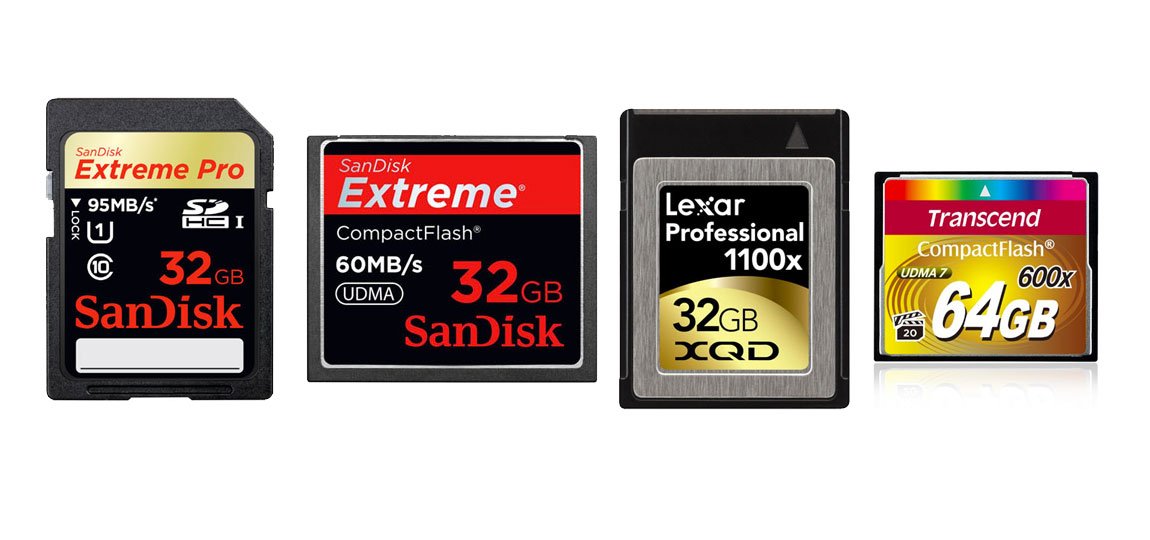Memory cards are a crucial component of your photography gear, directly impacting your camera’s performance and the efficiency of your workflow. Selecting the right memory card involves understanding various factors, including speed, capacity, and compatibility. This guide will help you make an informed decision to ensure you get the best performance for your photography needs.
1. Understanding Memory Card Types
SD Cards (Secure Digital):
- Types: SD, SDHC (High Capacity), and SDXC (Extended Capacity).
- Capacity: SD cards typically range from 2GB to 1TB, with SDHC supporting up to 32GB and SDXC ranging from 64GB to 1TB.
- Usage: Commonly used in most consumer and mid-range cameras. Ideal for general photography needs.
CF Cards (CompactFlash):
- Types: CF and CFast.
- Capacity: Generally available in larger capacities, ranging from 4GB to 512GB.
- Usage: Preferred in high-end and professional cameras due to their higher speed and durability.
XQD Cards:
- Types: XQD and CFexpress (an updated format).
- Capacity: Typically from 32GB to 256GB.
- Usage: Known for high speed and reliability, suitable for advanced and professional cameras.
MicroSD Cards:
- Types: Standard MicroSD, MicroSDHC, and MicroSDXC.
- Capacity: Ranges from 2GB to 1TB.
- Usage: Often used in compact cameras, drones, and action cameras.

2. Speed Class Ratings
Speed Classes:
- Class 2: Minimum write speed of 2MB/s. Suitable for basic photography.
- Class 4: Minimum write speed of 4MB/s. Suitable for standard photography.
- Class 6: Minimum write speed of 6MB/s. Suitable for HD video recording.
- Class 10: Minimum write speed of 10MB/s. Ideal for Full HD video and high-resolution photography.
UHS Speed Classes:
- UHS-I (U1): Minimum write speed of 10MB/s. Good for Full HD video recording.
- UHS-I (U3): Minimum write speed of 30MB/s. Necessary for 4K video recording and high-speed burst photography.
- UHS-II & UHS-III: Provide higher speeds, up to 312MB/s and 624MB/s respectively, suitable for professional use and high-speed data transfer.
V Ratings:
- V6: Minimum write speed of 6MB/s.
- V10: Minimum write speed of 10MB/s.
- V30: Minimum write speed of 30MB/s.
- V60 & V90: Higher speeds suitable for high-resolution video recording and continuous shooting.
3. Capacity Considerations
Capacity Needs:
- Low Capacity (16GB – 32GB): Suitable for casual photography or shorter shoots.
- Medium Capacity (64GB – 128GB): Ideal for travel, events, or extended shoots.
- High Capacity (256GB and above): Necessary for professional work, high-resolution photography, and long video recordings.
Usage Tips:
- Multiple Cards: Consider using multiple cards to manage your storage and reduce the risk of data loss.
- Backup: Always back up your data to multiple locations to prevent loss from card failure.
4. Card Reliability and Brand
Brand Reputation:
- Trusted Brands: Choose memory cards from reputable brands such as SanDisk, Lexar, Sony, and Samsung. These brands offer reliability and better customer support.
Durability:
- Weatherproof: Some cards are designed to be water-resistant, shockproof, and temperature-resistant. Useful for shooting in harsh environments.
Warranty:
- Manufacturer Warranty: Check the warranty period and coverage offered by the manufacturer to ensure you’re protected against defects.
5. Compatibility with Your Camera
Camera Manual:
- Check Specifications: Always refer to your camera’s manual or manufacturer’s website for compatible memory card types and maximum supported capacities.
Testing:
- Test Cards: Test new memory cards with your camera before important shoots to ensure compatibility and performance.
6. Price vs. Performance
Budget Considerations:
- Cost vs. Need: Higher-speed and larger-capacity cards are more expensive. Balance your budget with your specific needs and the performance required for your photography.
Performance Needs:
- Match Speed to Use: Invest in faster cards if you’re shooting high-resolution video or engaging in high-speed continuous shooting.
Conclusion
Choosing the right memory card for your photography needs involves understanding the different types, speed classes, capacities, and brand reliability. By selecting a card that matches your camera’s requirements and your photography style, you can ensure optimal performance and avoid potential issues during shoots. Consider your specific needs, test your cards, and invest in reliable brands to get the most out of your photography experience.











